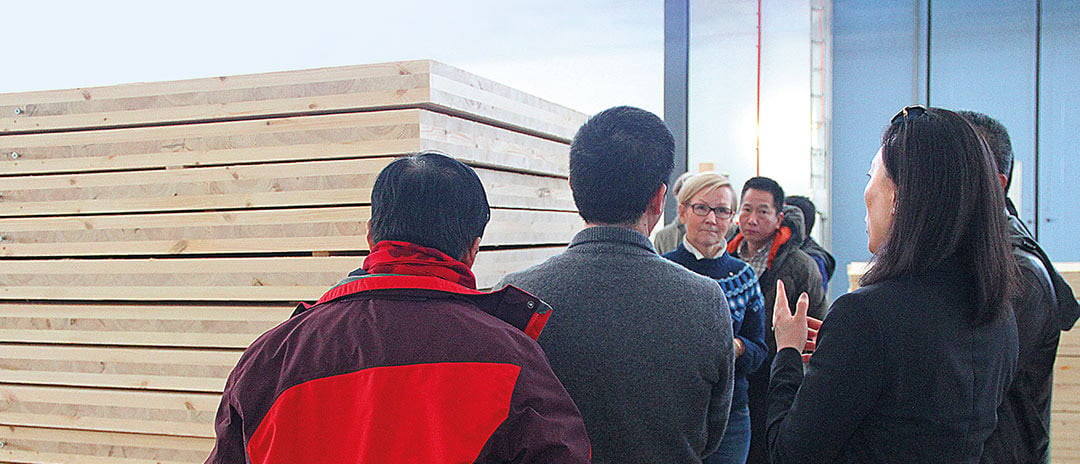Building materials make up a significant share of greenhouse gas emissions during a building’s life cycle, and their relative importance increases as the energy efficiency of buildings improves.
The requirements for low-carbon and recyclable construction products have boosted the development of new wooden structures. As a renewable raw material, wood has become one of the materials with the most potential in the world. Wood is a versatile building material: it is simultaneously a load-bearing structure, heat insulator, vapour and air barrier, as well as a moisture balancer. It also has naturally antibacterial internal and external surfaces. In addition, the production of wood products produces energy. Carbon dioxide bound by wood is stored by wooden structures for the entire lifetime of the building.
Of all massive wood materials that are suitable for the quick construction of apartment blocks and other large locations, Cross Laminated Timber (CLT) has quickly become a common construction material. CLT is used to manufacture installation-ready large, accurate panels and their details. In order to make housing production as efficient as possible, CLT panels are generally assembled and equipped as completely finished building block modules. The use of CLT panels, which are easy to handle on site, has quickly become more common even though the complete execution process, from designing to finishing the building, needs new suitable methods.
As a result of wood construction, construction is moving from construction sites to factories, with the exception of the installation of elements. A high grade of prefabrication creates various benefits: faster and more efficient construction; reduced need for site-specific storage; improved quality control; improved cost efficiency; more focus on occupational safety; more efficient supply chain management; and reduced significance of seasons. Industrial construction also has a positive impact on the development of productivity in the construction sector, which has not risen since the 1970s. In addition, indoor moisture issues can be minimised by building and installing the elements under weather guards.
Cross-laminating has quickly reached a foothold in the production of logs as well. The method enables the production of non-settling logs, which facilitates construction and produces cost-savings. It is possible to combine different materials with non-settling logs without leaving margins for settling. There is also no need for adjustment and maintenance measures, which are typical for traditional log buildings.
The market share of industrial logs in the construction of detached houses increased from 11% in 2010 to 27% in 2020. The growth seems to be accelerating.
Tytti Ahoranta
Project Manager, Circular Economy Solutions for the Built Environment
p. +358 40 504 2257

The EU’s transition towards a circular and climate-neutral economy represents an economic and social necessity and an opportunity for businesses and citizens. The role of SMEs in this environment will be crucial. The EU-funded DigiCirc project will permit SMEs to leverage digital technology as a key enabler for innovative circular products, services and business models to meet the goals that EU circular economy policies set. The project will establish and coordinate the DigiCirc innovation network, bringing together a wide range of stakeholders.
Hankkeen tavoitteena on turvata puunkorjuun toimintaedellytyksiä ja samalla edistää kiertotaloutta. Hankkeessa testataan CLT-levyn soveltuvuutta parantamaan pehmeiden kohteiden maaperän kantavuutta ja tilapäisenä siltaratkaisuna esimerkiksi ojien ylitykseen. Osa testattavista CLT-levyistä valmistetaan tuotestandardin mukaisen puutavaran sijaan sahateollisuuden sivuvirroista, joten samalla saadaan tietoa mahdollisuudesta lisätä näin toimialan materiaalitehokkuutta ja kannattavuutta.
Hankkeen tavoitteena on edistää alueellisia teollisia symbiooseja ja luoda uutta liiketoimintaa hyödyntämättömistä materiaali- ja energiavirroista. Hankkeen kohderyhmänä ovat sekä pk- että suuryritykset. Lisäksi hankkeen tavoitteena on pohjoismaista yhteistyötä hyödyntäen kehittää teollisia symbiooseja edistävien kehittäjäorganisaatioiden osaamistasoa ja luoda yhteisiä toimintamalleja kestävän kehityksen mukaisten liiketoimintamallien edistämiseksi.
Hankkeen tavoitteena on löytää kasvuhakuisia ja -kykyisiä, kansainvälisille markkinoille tähtääviä lappilaisia pk-yrityksiä, löytää niille kumppanuuksia ja rahoituslähteitä sekä kehittää AS-klusterien toimintaa yritysten avulla ja yritysten toimintaa klusterien avulla. Tavoitteena on saada kehittämisperusteita yrityksiltä, ja kehittää alueen tki-toimintaa niihin perustuen.
Hankkeessa painottuu puurakentamisen potentiaalin esille tuonti yhtenä kestävän kehityksen mukaisena, vähähiilisenä rakentamisen vaihtoehtona ja osana kestävän rakentamisen klusterin toimintaa. Rakentamiseen tarvitaan ratkaisuja, jotka eivät perustu luonnonvarojen tuh laavaan käyttöön, kuten vallitseva tilanne rakentamisessa globaalisti edelleen on. Hankkeessa tuodaan esille puurakentamiseen liittyvää energia- ja materiaalitehokkuutta sekä ilmastovaikutuksia vähentäviä tuotantoprosesseja, toimintamalleja ja tuotteiden t&k&i- ja liiketoimintaa.
Kemin Digipolis Oy on osatoteuttajana Nya möjligheter för CLT-hankkeessa, joka toteutetaan aikavälillä 1.9.2015-31.5.2018. Muut hankekumppanit ovat Centria tutkimus ja kehitys (FI), Lapin ammattikorkeakoulu Oy (FI), Luulajan teknillinen yliopisto (SE) ja SP Ruotsin tekninen tutkimuslaitos (SE). Hankkeen tavoitteena on lisätä tietoutta CLT:stä ja sen eduista rakennusmateriaalina. Hankkeessa tunnistetaan, kehitetään, simuloidaan ja analysoidaan uusia, kilpailukykyisiä rakenneratkaisuja ja laajennetaan innovaatioverkostoja mahdollisilla norjalaisilla yhteistyökumppaneilla.